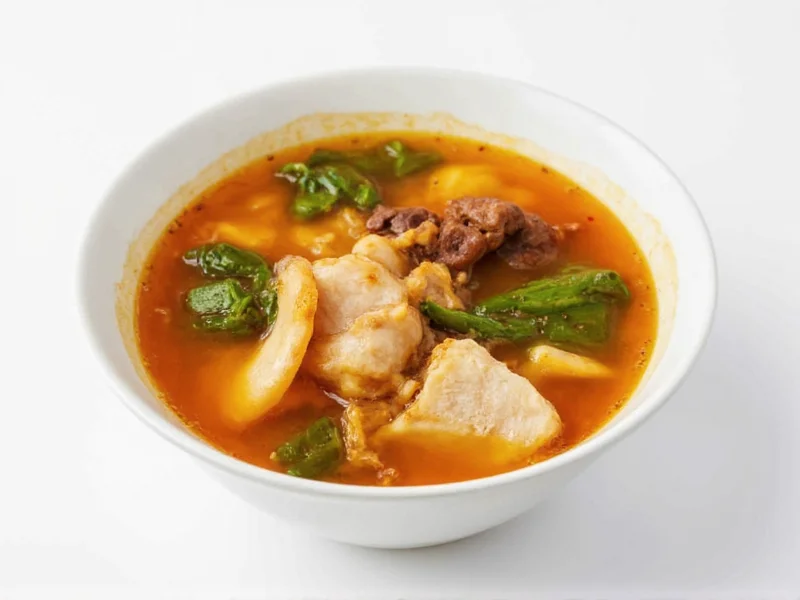Miso soup represents one of Japan's most beloved culinary traditions, offering both comforting warmth and notable nutritional benefits. Understanding the precise calories in traditional miso soup helps health-conscious individuals incorporate this fermented delight into balanced meal plans. This comprehensive guide examines the nutritional profile of miso soup while addressing common questions about its role in healthy eating patterns.
Factors Influencing Miso Soup Calorie Count
The how many calories are in miso soup question doesn't have a single definitive answer because multiple variables affect the final nutritional profile. Let's examine the key factors that determine the miso soup calorie count:
Miso Paste Quantity and Type
The foundation of miso soup comes from miso paste, which typically contributes 25-50 calories per tablespoon. Different miso varieties affect both flavor and caloric content:
| Miso Type | Calories per Tablespoon | Flavor Profile |
|---|---|---|
| White Miso (Shiro) | 30-35 | Mild, slightly sweet |
| Red Miso (Aka) | 40-45 | Strong, robust, salty |
| Barley Miso (Mugi) | 35-40 | Earthy, complex |
Additional Ingredients
Traditional miso soup often includes supplementary components that impact the miso soup nutrition facts:
- Tofu: Adds approximately 20-30 calories per 2-ounce serving
- Seaweed (wakame): Contributes minimal calories (about 5 per serving)
- Green onions: Adds negligible calories (approximately 2 per tablespoon)
- Vegetables: Mushrooms or daikon radish add 5-15 calories per serving
Nutritional Profile Beyond Calories
While calories of miso soup represent a primary concern for many, the complete nutritional value offers additional health insights. A standard 1-cup serving typically provides:
| Nutrient | Amount per 1 Cup | % Daily Value |
|---|---|---|
| Calories | 35-70 | 2-4% |
| Protein | 2-4g | 4-8% |
| Carbohydrates | 4-8g | 1-3% |
| Fat | 1-2g | 1-3% |
| Sodium | 600-900mg | 25-40% |
Protein Content and Digestibility
The miso soup protein content deserves special attention. The fermentation process breaks down soy proteins into more digestible forms, enhancing amino acid availability. This makes miso soup an excellent option for those seeking easily absorbed plant-based protein.
Sodium Considerations
One significant nutritional aspect requiring attention is sodium content. While miso soup offers probiotic benefits, its sodium in miso soup levels can reach 600-900mg per serving. Those monitoring sodium intake should consider:
- Using reduced-sodium miso paste
- Diluting with additional dashi broth
- Adding miso paste off-heat to preserve flavor while using less
Restaurant vs Homemade Miso Soup Calories
Understanding the difference between commercial and homemade preparations helps manage miso soup calorie count restaurant expectations. Restaurant versions often contain higher calorie counts due to:
- Increased miso paste concentration for stronger flavor
- Added oils or fats for texture enhancement
- Larger serving sizes (often 1.5-2 cups)
- Additional high-calorie ingredients like extra tofu or seaweed
A typical restaurant serving may contain 60-100 calories compared to 35-70 calories in carefully prepared homemade versions. Those interested in precise control should explore low calorie miso soup recipe options that maintain flavor while reducing caloric density.
Health Benefits and Dietary Considerations
The miso soup nutritional value extends far beyond basic macronutrients. This fermented food offers several health advantages:
Probiotic Powerhouse
Miso contains beneficial bacteria that support gut health. The fermentation process creates live cultures similar to those found in yogurt and kefir, promoting digestive wellness and immune function.
Weight Management Support
Many wonder is miso soup good for weight loss. The answer lies in its nutrient density and satiety factor. With only 35-70 calories per serving but significant flavor and umami satisfaction, miso soup makes an excellent pre-meal option to reduce overall calorie consumption.
Dietary Adaptability
Miso soup accommodates various dietary needs when prepared thoughtfully:
- Vegan: Naturally plant-based when using kombu dashi
- Gluten-free: Choose rice-based miso varieties
- Low-carb: Minimal carbohydrates in traditional preparations
Creating Lower-Calorie Miso Soup
For those seeking to minimize caloric intake without sacrificing flavor, consider these evidence-based strategies for low calorie miso soup recipe development:
- Dilute the broth: Use 1.5-2 cups of dashi for each tablespoon of miso paste
- Maximize vegetables: Add mushrooms, spinach, or bok choy for volume with minimal calories
- Control portion size: Stick to 1-cup servings to manage total intake
- Select lighter miso varieties: White miso generally contains fewer calories than red varieties
- Avoid added oils: Skip sesame or other oils that increase caloric density
These adjustments maintain the authentic flavor profile while creating a more diet-friendly option. The resulting homemade miso soup calories can stay at the lower end of the 35-70 calorie range.
Miso Soup in Balanced Nutrition
When evaluating miso soup nutrition facts within a complete diet, consider its role as a complementary food rather than a meal replacement. Its moderate protein content, probiotic benefits, and low calorie profile make it an excellent addition to balanced meal plans. Nutritionists often recommend miso soup as:
- An appetizer to reduce main meal portion sizes
- A light lunch option paired with a protein source
- A soothing evening meal component for weight management
The versatility of miso soup allows for customization based on individual nutritional goals while maintaining its fundamental health benefits and distinctive umami flavor.











 浙公网安备
33010002000092号
浙公网安备
33010002000092号 浙B2-20120091-4
浙B2-20120091-4